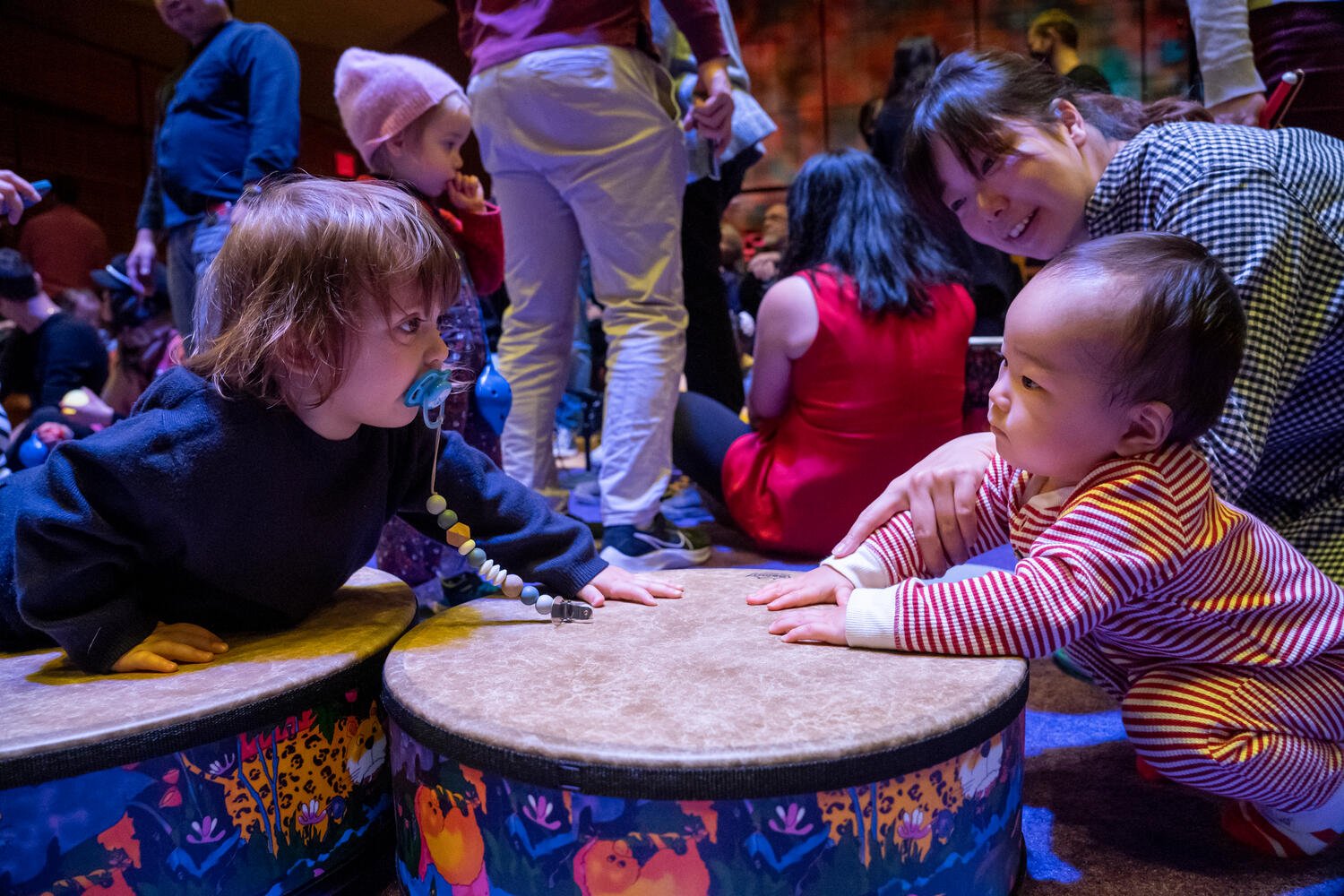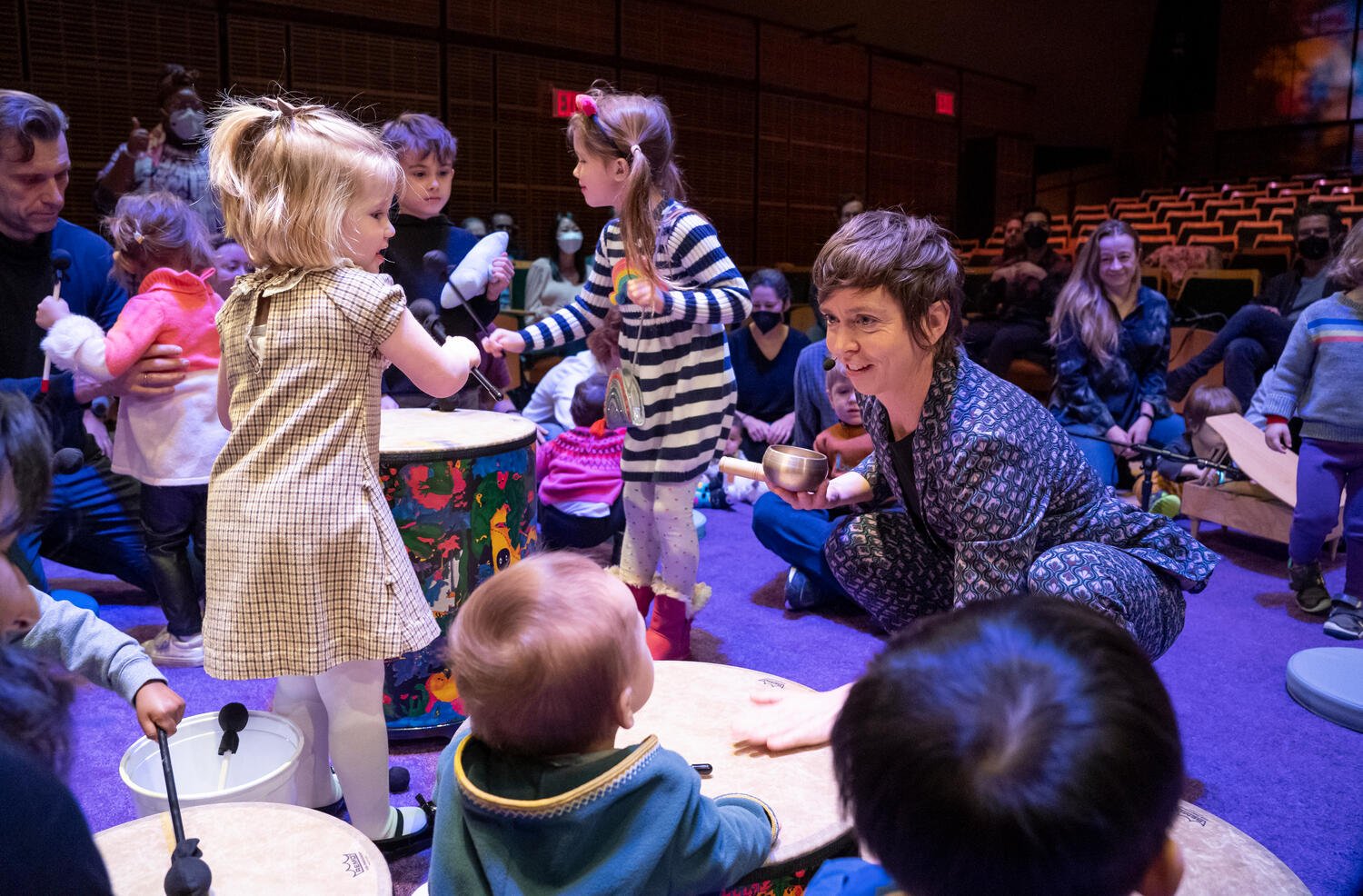
Photo: Stephanie Berger.
Day of listening
First launched at Carnegie Hall as part of Claire’s 2022–2023 Debs Creative Chair, the Day of Listening is a traveling experience that blurs the lines between listening, learning, and performing. Celebrating Pauline Oliveros, the visionary composer and performer known for her concept of “Deep Listening,” the Day of Listening invites community members of all ages to engage with several of Oliveros’s important works composed for open instrumentation and interpretation.
A review by Thomas May for Musical America of the latest “Day of Listening” event that was held at The Ebell in Los Angeles, CA on Nov. 17, 2024:
Claire Chase, Pauline Oliveros, and Quantum Listening in LA
By Thomas May
Musical America
December 3, 2024
LOS ANGELES—Since her death eight years ago last month, Pauline Oliveros has been proving her relevance from one crisis to the next. Global performances via Zoom of her group-based work The Tuning Meditation, perhaps the best-known of this great American composer’s landmark 1971 collection Sonic Meditations, fulfilled a desperately needed sense of community during the terrifying early months of the pandemic shutdown in 2020.
The Tuning Meditation similarly served as a communal bonding ritual during the first part of A Day of Quantum Listening, one of the performance events included under the capacious umbrella of PST ART: Art & Science Collide. The PST ART initiative, which the Getty Foundation is presenting in museums and performance spaces across Southern California through mid-February 2025, focuses on intersections between the arts and sciences.
"A Day of Quantum Listening" in the courtyard of LA's Ebell Center, Part of PST ART
Held on Nov. 17, not long after the U.S. presidential election, A Day of Quantum Listening had an added layer of resonance. “Pauline believed that we could listen beyond the edges of our imaginations and, in doing so, bring about a more harmonious world,” as the flutist and interdisciplinary artist Claire Chase noted in her introductory remarks.
Chase curated and hosted this three-hour-long celebration of Oliveros’s legacy at the Ebell of Los Angeles, a historic women’s club and performing arts venue near Hancock Park in LA’s Mid-Wilshire neighborhood.
The afternoon unfolded on several levels: as an introduction to the guiding ideas central to Oliveros’s philosophy and practice; as a free-for-all workshop for the participants (from very young children to seasoned concertgoers); as a spontaneous collective performance; and as the culmination of the four-part series Quantum Vibrations, which the LA-based cultural historian Josh Kun designed as his contribution to PST ART.
“Oliveros’s idea of quantum listening offers the perfect framework to think about music and science,” according to Kun, vice provost for the arts at University of Southern California, who has curated projects for each edition of the Getty PST series to date. “This idea of the quantum—that we can listen to small things and to multiple realities at the same time—is especially meaningful when people are hungry for opportunities to be together, to listen to each other.”
Kun and Chase, who are both MacArthur Fellows, initially met at a reunion of alumni of the prestigious fellowship. “Josh and I share an affinity for a DIY, scrappy, all-hands-on-deck way of doing things that’s perfect for any Pauline Oliveros project,” said Chase in an interview. Having heard about a 2023 iteration of the Quantum Listening program that Chase introduced in Carnegie Hall’s Zankel Hall, Kun invited the flutist to develop a version that would fit into the Getty PST ART content.
“We wanted to make it specifically LA-centric,” said Kun. “So we recruited a crew of local musicians who do thrilling work here in the city, from members of the Gay Freedom Band of Los Angeles to kids in the HOLA [Heart of Los Angeles] program.”
The Ebell, a distinctive jewel of Italian Renaissance Revival architecture, was also a key consideration because of its significance as a progressive Los Angeles institution. Established in 1894, the Ebell was founded with a mission to empower women through education and cultural activities but, according to Kun, “has been underused as a performance space.”
Quantum Listening: From Practice to Theory is the name of a manifesto Oliveros originally published in December 1999, linking her deep-listening meditations to activism. It’s a précis of her beliefs about the healing and community-building power of music.
What makes Oliveros’s work especially suited to an exploration of the intersection of art and science? “Who better to exemplify that encounter than Pauline? She’s one of the most genre-defying and also bridge-building artists of any era,” said Chase. “She refused to exclude anything from her listening. In that refusal—and it’s a political and ethical refusal as much as it is a creative and playful one—she cracks open this generous and capacious and boundlessly curious way of listening to the world that embraces disparate perspectives.”
All hands on board
Chase started the proceedings at the Ebell with “a little musical offering” by “Pauline’s good friend” Terry Riley: an excerpt from The Holy Liftoff, which Chase commissioned as part of her ongoing Density 2036 initiative. Riley’s modular score calls for an eight-voice chorus of low and high flutes, seven of them pre-recorded, with Chase playing the eighth part live.
The rest of the introductory session was devoted to examples of the practice of deep listening that lies at the core of Oliveros’s life work. Chase illustrated a few of the composer’s interactive meditation pieces in collaboration with a small ensemble of musical colleagues. Any distinction between performer(s) and audience was insistently dismantled.
Participants inside the Ebell: "Sing a tone that you hear in your imagination."
The Tuning Meditation, for example, was executed by encouraging everyone who wished to participate to follow Oliveros’s straightforward, text-based score: “sing a tone that you hear in your imagination” and then “listen for someone else’s tone and tune to its pitch as exactly as possible.” The piece is designed to develop uniquely and spontaneously, as everyone proceeds to contribute another tone of their choosing and then tunes to the tones of voices around them—a process that can be continued as long as desired.
Another hour was devoted to at-will exploration of various other text-based scores by Oliveros. Attendees roamed freely about two sprawling floors of the Ebell, where they could linger in different settings to take part in or simply observe close-up encounters with such pieces as Grand Buddha Marching Band and Sound Fishes.
In the center’s library, The Earthworm Also Sings, Oliveros’s poem dedicated to John Cage, was heard in an endless loop recording recited by Ione (Oliveros’s creative partner and spouse for decades). In this quieter space, visitors were asked to “join the experience by listening, walking around, lying down, or by responding to the text with your own sounds from an ocarina, a percussion instrument, or with your own voice or body.”
An especially popular attraction involved the adaptive-use musical instruments (AUMI) software that Oliveros co-developed at her Deep Listening Institute as a radically inclusive tool for making music. Regardless of musical background or even physical impairment, players can compose by triggering and sculpting sounds through motions or gestures (even the blink of an eye) that are tracked by a computer camera.
For the afternoon’s grand finale, everyone was summoned back to the main lounge to engage in another series of group performances, from clicking small rocks together in antiphonal choruses to a jam session with the AUMI screens. A surreal miniature symphony was produced en masse from “sounds you’ve never made before.” Chase closed the proceedings with a serene reprise of The Tuning Meditation around the courtyard fountain.
Oliveros was there in spirit, presiding over the communal experience she enabled
Intriguing as the sonic phenomena were in themselves, these ensemble pieces reached beyond musical parameters. They promoted an openness to listening in its most all-embracing sense—as a heightened awareness of, and corresponding empathy for, perspectives outside our own. For an afternoon at least, one could believe again in music’s ability to change the world.
Photos by Salvador Ochoa
Copyright © 2024, Musical America
Past Events
Day of Listening, January 22nd, 2023. Photo: Lawrence Sumulong.
Day of Listening, January 22nd, 2023. Photo: Lawrence Sumulong.
Day of Listening, January 22nd, 2023. Photo: Stephanie Berger.
Day of Listening, January 22nd, 2023. Photo: Lawrence Sumulong.
Day of Listening, January 22nd, 2023. Photo: Stephanie Berger.
Day of Listening, January 22nd, 2023. Photo: Stephanie Berger.
Day of Listening, January 22nd, 2023. Photo: Stephanie Berger.












